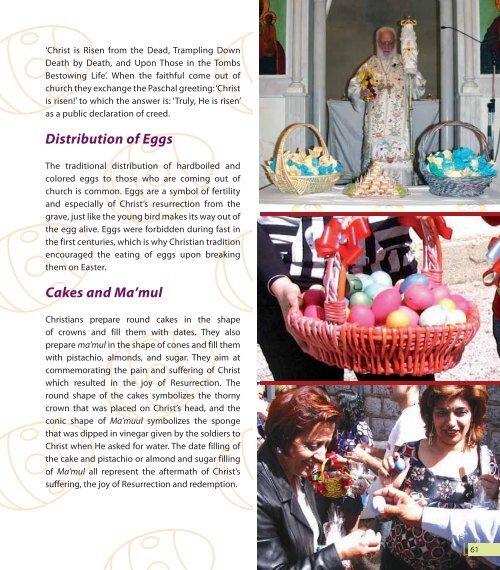Cultural aspects in Christian and Islamic religions - unesdoc - Unesco
Cultural aspects in Christian and Islamic religions - unesdoc - Unesco
Cultural aspects in Christian and Islamic religions - unesdoc - Unesco
You also want an ePaper? Increase the reach of your titles
YUMPU automatically turns print PDFs into web optimized ePapers that Google loves.
‘Christ is Risen from the Dead, Trampl<strong>in</strong>g Down<br />
Death by Death, <strong>and</strong> Upon Those <strong>in</strong> the Tombs<br />
Bestow<strong>in</strong>g Life’. When the faithful come out of<br />
church they exchange the Paschal greet<strong>in</strong>g: ‘Christ<br />
is risen!’ to which the answer is: ‘Truly, He is risen’<br />
as a public declaration of creed.<br />
Distribution of Eggs<br />
The traditional distribution of hardboiled <strong>and</strong><br />
colored eggs to those who are com<strong>in</strong>g out of<br />
church is common. Eggs are a symbol of fertility<br />
<strong>and</strong> especially of Christ’s resurrection from the<br />
grave, just like the young bird makes its way out of<br />
the egg alive. Eggs were forbidden dur<strong>in</strong>g fast <strong>in</strong><br />
the first centuries, which is why <strong>Christian</strong> tradition<br />
encouraged the eat<strong>in</strong>g of eggs upon break<strong>in</strong>g<br />
them on Easter.<br />
Cakes <strong>and</strong> Ma’mul<br />
<strong>Christian</strong>s prepare round cakes <strong>in</strong> the shape<br />
of crowns <strong>and</strong> fill them with dates. They also<br />
prepare ma’mul <strong>in</strong> the shape of cones <strong>and</strong> fill them<br />
with pistachio, almonds, <strong>and</strong> sugar. They aim at<br />
commemorat<strong>in</strong>g the pa<strong>in</strong> <strong>and</strong> suffer<strong>in</strong>g of Christ<br />
which resulted <strong>in</strong> the joy of Resurrection. The<br />
round shape of the cakes symbolizes the thorny<br />
crown that was placed on Christ’s head, <strong>and</strong> the<br />
conic shape of Ma’muul symbolizes the sponge<br />
that was dipped <strong>in</strong> v<strong>in</strong>egar given by the soldiers to<br />
Christ when He asked for water. The date fill<strong>in</strong>g of<br />
the cake <strong>and</strong> pistachio or almond <strong>and</strong> sugar fill<strong>in</strong>g<br />
of Ma’mul all represent the aftermath of Christ’s<br />
suffer<strong>in</strong>g, the joy of Resurrection <strong>and</strong> redemption.<br />
61

















